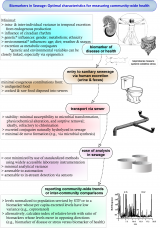Pathfinder Innovation Projects: Awardees for 2011
See below to learn more about the first year of Pathfinder Innovation Projects.
Screening the water in our pipes to identify active microorganisms
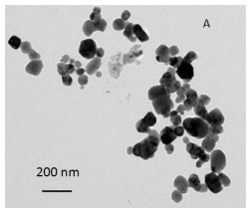 This transmission electron micrograph shows the copper nanoparticles used to inhibit Legionella growth.Building plumbing stays out of sight, as do the microorganisms that could live inside the pipes, such as Legionella pneumophila, which can cause debilitating respiratory disease and other symptoms. Yet measuring the success of water disinfection is difficult because these creatures are hard to study in their favored environment: our engineered water systems. EPA senior research microbiologist Nicholas Ashbolt developed a method to rapidly screen for genetic information generated by active Legionella that grow in pipes. Furthermore, the project demonstrated the effect of a new nanoparticle disinfectant on Legionella growth. This approach to identifying active microorganisms has applications in many other environments where biological contamination is a concern.
This transmission electron micrograph shows the copper nanoparticles used to inhibit Legionella growth.Building plumbing stays out of sight, as do the microorganisms that could live inside the pipes, such as Legionella pneumophila, which can cause debilitating respiratory disease and other symptoms. Yet measuring the success of water disinfection is difficult because these creatures are hard to study in their favored environment: our engineered water systems. EPA senior research microbiologist Nicholas Ashbolt developed a method to rapidly screen for genetic information generated by active Legionella that grow in pipes. Furthermore, the project demonstrated the effect of a new nanoparticle disinfectant on Legionella growth. This approach to identifying active microorganisms has applications in many other environments where biological contamination is a concern.
More information:
Read a paper published in Applied and Environmental Microbiology. Exit
Designing nanomaterials to mitigate potentially toxic effects
Modern computational toxicology empowers scientists to develop more sustainable chemicals that are less likely to harm human health or the environment. Elaine Cohen Hubal, EPA senior scientist, and Sumit Gangwal, EPA post-doctoral scholar, used this powerful approach to assess the potential toxicity of nanomaterials early in development. Materials developed by a collaboration of scientists were designed to become inert and degrade rapidly after use. These nanomaterials have the potential to replace the now-ubiquitous silver nanoparticles in common disinfectant applications. This type of advancement could become important as scientists explore the frontier of chemical exposure at the nano level.
Identifying biomarkers in sewage to measure the health of entire communities
Sewage contains the discarded by-products from our body processes, but it holds plenty of research potential for Christian Daughton, an EPA research physical scientist. He developed the concept of Sewage Chemical Information Mining (SCIM). SCIM determines if biomarkers found in raw sewage can be used as health indicators in people. If applied successfully, SCIM could enable nearly real-time diagnosis of health problems in entire communities by considering whole populations as composite “patients.”
More information:
Read an EPA blog.
Read a paper published in Science of the Total Environment. Exit
Read a second paper published in Science of the Total Environment. Exit
Testing how chemical mixtures affect humans
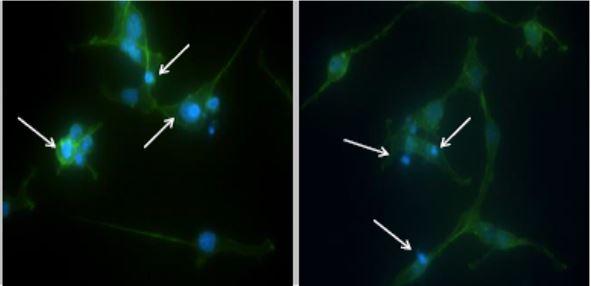 The arrows point to changes in cell proteins caused by adding mixtures of nickel, cadmium, and chromium.EPA research biologist Yue Ge established a quantitative approach to study how proteins in human cells respond to metal mixtures composed of nickel, cadmium and chromium. He showed that protein expression can serve as an indicator of chemical mixture exposure and toxicity. This research opens a new path to understanding chemical interactions and mixture toxicity. In the future, this research could provide new ways to analyze chemical interactions and corresponding health outcomes.
The arrows point to changes in cell proteins caused by adding mixtures of nickel, cadmium, and chromium.EPA research biologist Yue Ge established a quantitative approach to study how proteins in human cells respond to metal mixtures composed of nickel, cadmium and chromium. He showed that protein expression can serve as an indicator of chemical mixture exposure and toxicity. This research opens a new path to understanding chemical interactions and mixture toxicity. In the future, this research could provide new ways to analyze chemical interactions and corresponding health outcomes.
More information:
Read a paper published in the Journal of Proteome Research.
Detecting hazardous chemicals in streams with glowing tadpoles
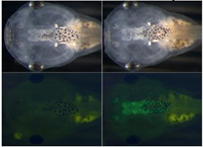 Tadpoles on the right were modified to glow in the presence of thyroid hormones.Numerous chemicals can affect a mother’s thyroid and produce developmental problems in fetuses, newborns and toddlers. EPA research scientist Mary Gilbert applied a new procedure that used tadpoles that glowed in the presence of thyroid-disrupting compounds. A modified gene produces a visible, fluorescent protein when a disrupting compound activates a tadpole’s thyroid gland. Someday, such research could produce sophisticated biomonitoring techniques to detect low-level contaminants in water sources in real time.
Tadpoles on the right were modified to glow in the presence of thyroid hormones.Numerous chemicals can affect a mother’s thyroid and produce developmental problems in fetuses, newborns and toddlers. EPA research scientist Mary Gilbert applied a new procedure that used tadpoles that glowed in the presence of thyroid-disrupting compounds. A modified gene produces a visible, fluorescent protein when a disrupting compound activates a tadpole’s thyroid gland. Someday, such research could produce sophisticated biomonitoring techniques to detect low-level contaminants in water sources in real time.
More information:
Read an EPA blog.
Read a Scientific American blog.Exit
Creating a mobile database to help individuals identify total exposure to common chemicals
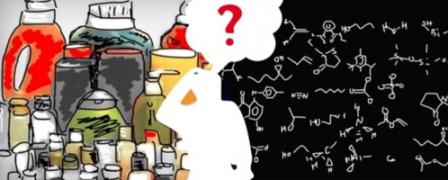 People encounter chemicals from consumer products every day, and a chemical ingredient database could link the use of consumer products to chemical exposures.Until now, estimating a person’s total exposure to chemicals in consumer products has proven almost impossible. Rocky Goldsmith, an EPA research physical scientist, developed a comprehensive database of chemicals in consumer products using information from major consumer retailers. Although such databases exist, the novelty comes with delivery — scan a product barcode with a phone to show a list of chemical ingredients. One day, this database might allow for total exposure assessments that estimate the number and types of chemicals to which an individual might be exposed and quickly provide that information in a format accessible with a cellphone.
People encounter chemicals from consumer products every day, and a chemical ingredient database could link the use of consumer products to chemical exposures.Until now, estimating a person’s total exposure to chemicals in consumer products has proven almost impossible. Rocky Goldsmith, an EPA research physical scientist, developed a comprehensive database of chemicals in consumer products using information from major consumer retailers. Although such databases exist, the novelty comes with delivery — scan a product barcode with a phone to show a list of chemical ingredients. One day, this database might allow for total exposure assessments that estimate the number and types of chemicals to which an individual might be exposed and quickly provide that information in a format accessible with a cellphone.
More information:
Read a paper published in Food and Chemical Toxicology. Exit
Read the EPA workshop summary report. (188 pp, 21 MB, About PDF)
Integrating EPA risk assessment decisions
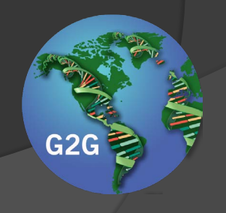 Better data flow will help connect and characterize health, ecology, and climate models.Annie Jarabek, EPA senior toxicologist, set out to create an EPA-wide platform to integrate the Agency’s risk assessment decisions with computational tools and supporting data, from global perspectives down to genetic effects. The computational platform would represent an important effort to improve coordination and cooperation throughout the Agency. Such a platform would also facilitate data management so EPA tools and products are readily accessible to the public. Recommendations from the project have the potential to streamline the flow of data throughout EPA offices and labs and with external stakeholders.
Better data flow will help connect and characterize health, ecology, and climate models.Annie Jarabek, EPA senior toxicologist, set out to create an EPA-wide platform to integrate the Agency’s risk assessment decisions with computational tools and supporting data, from global perspectives down to genetic effects. The computational platform would represent an important effort to improve coordination and cooperation throughout the Agency. Such a platform would also facilitate data management so EPA tools and products are readily accessible to the public. Recommendations from the project have the potential to streamline the flow of data throughout EPA offices and labs and with external stakeholders.
Linking global atmospheric and air quality models to show how the Amazon rainforest affects rainfall in North Carolina
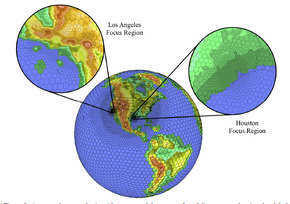 Global air and climate models are too broad for high-resolution local models.Global climate systems remain some of the most complex processes scientists study. Could the size of the Amazon rainforest affect rainfall in North Carolina? EPA physical scientist Martin Otte investigated this question by trying to develop a comprehensive system that would couple regional and global atmospheric models with relevant air quality models. If successful, this combined platform could allow scientists and policymakers to study the mechanisms by which climate change will alter regional and local air quality.
Global air and climate models are too broad for high-resolution local models.Global climate systems remain some of the most complex processes scientists study. Could the size of the Amazon rainforest affect rainfall in North Carolina? EPA physical scientist Martin Otte investigated this question by trying to develop a comprehensive system that would couple regional and global atmospheric models with relevant air quality models. If successful, this combined platform could allow scientists and policymakers to study the mechanisms by which climate change will alter regional and local air quality.
Scaling environmental knowledge to give communities more information about their environments
 Power worked to link global atmospheric and air quality models.James Power, EPA research fishery biologist, compiled an extensive literature review to demonstrate a proof-of-concept technique that would connect models. The project sought to explain how to collect, evaluate and use information obtained at small scales of time and geography so that information could support management decisions at larger scales. This work, when extended, would allow planners, assessors, decision makers and communities to understand information about environmental patterns and processes at a scope not previously possible.
Power worked to link global atmospheric and air quality models.James Power, EPA research fishery biologist, compiled an extensive literature review to demonstrate a proof-of-concept technique that would connect models. The project sought to explain how to collect, evaluate and use information obtained at small scales of time and geography so that information could support management decisions at larger scales. This work, when extended, would allow planners, assessors, decision makers and communities to understand information about environmental patterns and processes at a scope not previously possible.
Creating a novel biofilter to safely eliminate disinfection by-products from drinking water
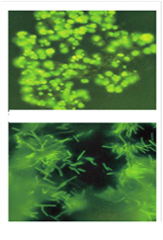 Bacteria such as these can become biofilters that clean drinking water.E. Sahle-Demessie, an EPA chemical engineer, developed a hybrid chemical and biological method that eliminates more than 90 percent of disinfection by-products from chlorinated drinking waters. The process uses bacteria and microbes to absorb and decontaminate the water and converts the disinfectant agents into methane, which can be captured. Down the line, such a method could yield cleaner water and sustainable by-products on a large scale.
Bacteria such as these can become biofilters that clean drinking water.E. Sahle-Demessie, an EPA chemical engineer, developed a hybrid chemical and biological method that eliminates more than 90 percent of disinfection by-products from chlorinated drinking waters. The process uses bacteria and microbes to absorb and decontaminate the water and converts the disinfectant agents into methane, which can be captured. Down the line, such a method could yield cleaner water and sustainable by-products on a large scale.
Using satellite imagery to measure water quality
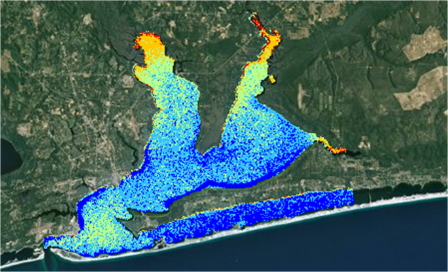 Satellites help determine water quality factors such as turbidity and chlorophyll concentration.Blake Schaeffer, an EPA research ecologist, led a team that aimed to bring greater clarity to monitoring coastal waters. Current monitoring of the near-coastal zone relies on manual sampling in estuaries, beaches and bays. The team used the Hyperspectral Imager for the Coastal Ocean, mounted on the International Space Station, for water quality readings. Schaeffer and his colleagues then matched the data with boat-based readings to test the accuracy of the space station information. In the future, such monitoring data could result in daily water forecasts.
Satellites help determine water quality factors such as turbidity and chlorophyll concentration.Blake Schaeffer, an EPA research ecologist, led a team that aimed to bring greater clarity to monitoring coastal waters. Current monitoring of the near-coastal zone relies on manual sampling in estuaries, beaches and bays. The team used the Hyperspectral Imager for the Coastal Ocean, mounted on the International Space Station, for water quality readings. Schaeffer and his colleagues then matched the data with boat-based readings to test the accuracy of the space station information. In the future, such monitoring data could result in daily water forecasts.
More information:
Read a paper published in the International Journal of Remote Sensing. Exit
Read a second paper published in the International Journal of Remote Sensing. Exit
Read a paper published in GIScience & Remote Sensing. Exit
Watch a NASA TV interview about the International Space Station work. Exit
Read about the International Space Station research awards.
Read a Deloitte case study. Exit
Read an EPA blog.
Read an EPA interview.
Read about the collaboration with NASA.
Creating composites that break down in sunlight to shorten the life cycle of common plastics
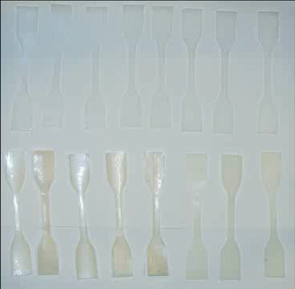 The bottom row of plastics have degraded after exposure to sunlight. Plastics often remain stable for decades, blighting oceans and clogging landfills. EPA senior research scientist Richard Zepp created a next-generation plastic composite that stays inert indoors but degrades outside in the UV spectrum of sunlight. Supplementing current recycling efforts, this approach has the potential to significantly reduce plastic waste life cycles in the environment.
The bottom row of plastics have degraded after exposure to sunlight. Plastics often remain stable for decades, blighting oceans and clogging landfills. EPA senior research scientist Richard Zepp created a next-generation plastic composite that stays inert indoors but degrades outside in the UV spectrum of sunlight. Supplementing current recycling efforts, this approach has the potential to significantly reduce plastic waste life cycles in the environment.
More information:
Read an EPA blog.
Read an EPA interview.


